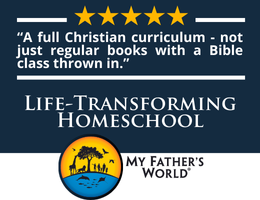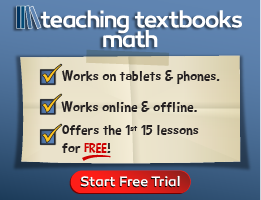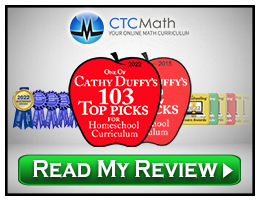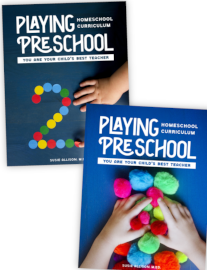Playing Preschool is a two-year program that introduces reading, math, science, and art through play and hands-on activities. Playing Preschool’s overarching goal is to help children become well-rounded learners who ask questions, learn to think, and develop curiosity.
For each year, you purchase a PDF coursebook with more than 300 pages. The first 25 or so pages in each coursebook explain the program, and the rest of the pages are lesson plans that don’t need to be printed out. Using the books in digital format also lets you use the occasional hyperlinks. Along with the coursebook you receive a printable file of alphabet pages for creating an alphabet portfolio. (This is the closest the program comes to something like worksheets.)
Each year’s program takes 38 weeks and is arranged in two-week units. Every unit has its own theme and is linked with one or two letters of the alphabet. Sometimes the themes and letters match up, such as both uppercase and lowercase “A” taught with the theme of apples or the letter “F” taught with a farm theme. However, the unit on water teaches the letter “I.”
Reading and math skills are taught every week. The unit themes expand learning into science (e.g., the human body, the five senses, plants, magnets) and other topics that don’t fit under academic headings, such as construction, pets, emotions, and textures.
The daily lesson plans for each unit begin with an overview, a supply list, a list of suggested books to read, a poem, and a song. At the top of each week’s lesson plan chart are the unit goals and guiding questions. The chart for each week is followed by daily lesson plans with specific instructions for the activities.
Lessons are not scripted although leading questions are provided within some sections of the lesson plans. Parents are encouraged to adapt lesson plans as needed, and many activities might be done in several different ways.
You will use many supplies regularly, such as colored construction paper, sticky notes, tempera paint, cotton balls, uncooked rice, dice, a 28-quart storage container (used for sensory activities), and kraft or butcher paper. Additional supplies required each week are sometimes unusual (e.g., a toy or plastic spider and ingredients for making ice cream in a bag), so you’ll want to plan to make sure you have what you need each week. You can easily expand the program for more than one child at minimal cost since many of the supplies can be shared by more than one child.
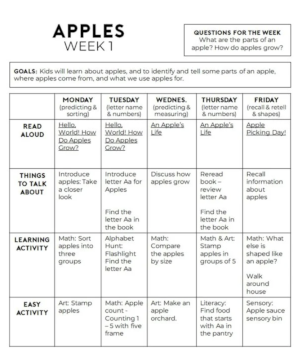 The weekly lesson plan charts show four types of lessons and activities for each day in the left-hand column:
The weekly lesson plan charts show four types of lessons and activities for each day in the left-hand column:
- Read aloud: Six books that should be available at your library are listed for each unit, and you will spend one or two days reading (or re-reading) each book. You can substitute other books for those listed. Reading aloud and discussing books is a vital part of these courses since it builds listening and comprehension skills, helps children develop critical thinking skills, gives them opportunities to retell stories, discuss characters, and much more.
- Things to talk about: This is the time to discuss the theme, applying what they have heard in the read-aloud book and what they know from their life experience. In the discussion, you will also connect the theme to the upcoming learning activity, and you might introduce new vocabulary.
- Learning activity: This is the core learning activity where students learn concepts and skills through discussion and activities such as sorting, hunting, grouping, experimenting, measuring, creating alphabet portfolio pages, and playing games. The second year adds the school skills of cutting, gluing, folding, tracing, using tape, and pre-writing.
- Easy activity: These relatively easy activities reinforce learning and are often open-ended. For example, one activity in the first course has you draw a face on an egg, recite “Humpty Dumpty” with your child, and then together push the egg off a “wall” onto a cookie sheet. Children can experiment with eggs falling from different heights (p. 65). The second course has more challenging activities, such as hunting for items that represent rhyming words, going on a “rock finding walk,” painting rocks, or performing a science experiment.
What Is Taught in Each Course
The top headings for columns in the daily lesson plans apply primarily to reading and math skills while the goals and “Questions of the week” for each unit describe theme-related learning.
The column headings for each day differ for the two courses, but they don’t reflect an exclusive emphasis for each day. Every day’s read-aloud book relates to the unit theme as do most of the other activities, whether they are teaching math skills, reading skills, science, art, or something else. For example, the first course’s unit on colors has students sort toys by color, set up a freight train in the house (built from toy trains, blocks, bricks, boxes, colored paper, or whatever you want), make a Froot Loop necklace, mix colors in water and with paint to make new colors, and paint a sunshine—all alongside discussions and activities that teach children about the letter R and the specific color featured each day.
For the first course, the column headings are:
Monday – predicting and sorting
Tuesday – letter name and numbers
Wednesday – predicting and measuring
Thursday – letter name and numbers
Friday – recall and retell and shapes
In the first course, children are introduced to the letters of the alphabet and their primary sounds, recalling and retelling stories, predicting what might happen in a story, sorting, classifying, and recognizing shapes. Children create an alphabet portfolio with a letter-themed art project for each letter. For math readiness, they are introduced to numbers, beginning counting, measurement, graphing (done with objects), sorting, and shapes. In addition, each day begins with a daily calendar routine that teaches days of the week, months of the year, and weather. Songs are included for all three. Children will also listen to and learn (not necessarily memorize) the song and poem for each unit.
The column headings for the second-year course are:
Monday – reading comprehension and math skills
Tuesday – letter sounds and number sense
Wednesday – reading comprehension and math skills
Thursday – letter sounds and number sense
Friday – recall and retell and school skill
The second-year program advances in difficulty. It reviews letters and their sounds (supported by the creation of an alphabet portfolio) and goes deeper into reading skills, focusing on comprehension, the sequence of events, cause and effect, comparison and contrast, story elements (e.g., characters and setting), predicting what might come next, and vocabulary words. Number sense continues with counting (to 20) and number recognition, but it adds one-to-one correspondence; concepts of more, less, and equal; beginning addition and subtraction; graphing; patterns; and ordering numbers. This course does not teach reading and writing.
Summary
Either Playing Preschool course can be used on its own, and children completing the second course should be well-prepared for kindergarten. They should be familiar with letters and sounds but not blending sounds and actual reading. Maybe even more importantly, they will develop listening, thinking, and speaking skills that build a crucial foundation for future learning.

